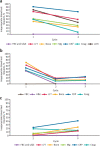Reducing inappropriate blood testing in haematology inpatients: A multicentre quality improvement project
- PMID: 33762376
- PMCID: PMC8002792
- DOI: 10.7861/clinmed.2020-0250
Reducing inappropriate blood testing in haematology inpatients: A multicentre quality improvement project
Abstract
Haematology inpatients are subject to extensive blood testing and many of these tests could be deemed inappropriate as they are not indicated for monitoring or clinical symptoms. Unnecessary testing exposes the patient to the risks of phlebotomy and adds resources' strain to the NHS.Our aim was to reduce the number of inappropriate blood tests performed on haematology inpatient wards.Quality improvement projects (QIPs) were performed in four haematology units introducing inpatient blood testing schedules (BTS) or providing staff education on current schedules.A reduction in inappropriate or overall blood testing was achieved at every site where a BTS was implemented, with a median reduction in inappropriate blood testing of 24.7% and estimated cost savings of up to £38,438 per annum.This QIP can be safely adapted to a variety of inpatient settings and is associated with cost savings. This initiative could be extended to other inpatient departments throughout the NHS.
Keywords: blood test; haematology; inpatient; phlebotomy; quality improvement.
© Royal College of Physicians 2021. All rights reserved.
Figures




References
-
- Koch CG, Li L, Sun Z, et al. . Hospital-acquired anemia: prevalence, outcomes, and healthcare implications. J Hosp Med 2013;8:506–12. - PubMed
-
- Jalbert R, Gob A, Chin-Yee I. Decreasing daily blood work in hospitals: What works and what doesn’t. Int J Lab Hematol 2019;41(Suppl 1):151–61. - PubMed
-
- World Health Organization . WHO guidelines on drawing blood: best practices in phlebotomy. WHO, 2010. - PubMed
-
- Tinegate H, Birchall J, Gray A, et al. . Guideline on the investigation and management of acute transfusion reactions Prepared by the BCSH Blood Transfusion Task Force. Br J Haematol 2012;159:143–53. - PubMed
Publication types
MeSH terms
LinkOut - more resources
Full Text Sources
Other Literature Sources

